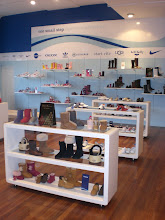Here at One Small Step, we train our staff to the highest possible standard using the Brannocks measuring device. Even though it is old fashioned looking, to this day there has been no other device made which delivers better accuracy whilst measuring children's feet. Something we consider VERY important here.
We thought we would share some of our knowledge with our lovely blog and twitter followers and who knows, you might learn something!
When getting your children's feet measured it is very important that you ask yourself these three questions so that we can help you find the perfect shoe and the perfect fit...
1. How does the shoe fit?
2. How is the shoe made?
3. Is the type of shoe appropriate for your child's age?
We have something for every foot here; be it wide, narrow, shallow, tiny, big or have high insteps. It is important for us to know exactly what kind of shoe you are after so that we can give you the best shoe fitting service available. We all know that some children can be restless and can easily become agitated in certain environments which is why our staff are here to answer any questions and offer expert advice about all of our shoes and fitting.
We cannot stress enough how important it is to get your children's feet measured on a regular basis. (Every 4-6 weeks for children up to 3 years then every 6-8 weeks for children between 4-10 then every 8-12 weeks for children over 10.) Poorly fitting children's shoes can cause no end of problems. For example; ingrown toenails, hammer toes, calluses, bunions and not to mention a fear of getting their feet measured and fitted for shoes.
Lots of people think that by going up a shoe size your child will have plenty of growing room and will do no harm. This is FALSE. Here at One Small Step, we fit all of our shoes with adequate growing room. Shoes that are sizes too big can cause just as many problems with a child's foot than shoes which are sizes too small.
When should I get my child measured for their first shoes?
You can get your child measured at any age so you can keep track of their shoe size and foot development, although babies and crawlers don't require shoes. They only need booties, warm wide sock to keep their feet warm, or pre-walking shoes that do not bind their feet. The shoe should be flexible rather than providing a rigid support, and it's very important for the shoe to be shaped like the childs foot. Note that babies feet are not shaped like children who can walk - they are more triangular with a layer of fat on the top of the foot. The bones in a babies foot do not form until they begin to walk, whereby the cartilage hardens and turns to bone.

No comments:
Post a Comment